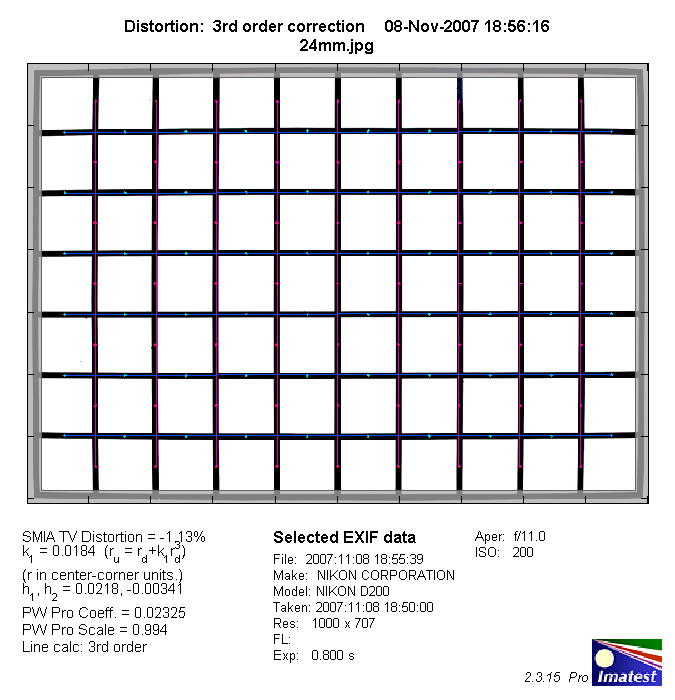|
Nikkor AF-S 24-70mm f/2.8G ED - Review / Test Report - Analysis |
|
Lens Reviews -
Nikon / Nikkor (APS-C)
|
|
Page 2 of 3
Distortion
Similar to its predecessor the AF-S 24-70mm ED exhibits a very slight degree (~1.1%) of barrel
distortion at 24mm decreasing to marginal pincushion distortion beyond. This is exceptional
for a standard zoom lens (on an APS-C DSLR).
Please note that some users reported that the lens seems to produce a quite hefty amount of
barrel distortion at 24mm when used on a full format DSLR.
|
Move the mouse cursor over the focal length text marks below to observe the respective distortions
|
| 24mm |
40mm |
70mm |
|

|
The chart above has a real-world size of about 120x80cm.
Vignetting
Thanks to its full frame design the Nikkor AF-S 24-70mm ED shows very little
vignetting on the D200. At 24mm and 40mm the issue is already negligible at
wide-open aperture. The problem increases marginally towards 70mm but
it is still not really field relevant here even at f/2.8.

MTF (resolution)
The AF-S 24-70mm f/2.8 ED produced very good to exceptional resolution figures
in the MTF lab. The center resolution is excellent to outstanding throughout
of the tested aperture range. At 24mm and 40mm the center resolution is likely
to match and possibly even exceed a 10mp sensor resolution and that's also at f/2.8
which is quite amazing. The borders aren't quite as impressive but still very good at large
apertures and excellent at medium aperture settings. There's a slight drop
is quality at 70mm but even here the lens is darn good. On the downside
the field curvature is fairly pronounced at 24mm so you need to stop down sufficiently
when shooting flat objects at this setting - otherwise your background will run
out-of-focus (depth-of-field). The tested sample showed a very good
centering quality.
Please note that the MTF results are not directly comparable across the different systems!
Below is a simplified summary of the formal findings. The chart shows line widths per picture height (LW/PH) which can be taken as a measure for sharpness.
If you want to know more about the MTF50 figures you may check out the corresponding Imatest Explanations
Chromatic Aberrations (CAs)
On the average chromatic aberrations (color shadows at harsh contrast transitions)
are comparatively low for a standard zoom lens. Unfortunately the CAs were a bit
unsymmetrical in the tested sample making it difficult to remove all CA traces via
post-processing.

Field Curvature (updated: 03/15/2008)
Field curvature refers to the shape of the focus field. In a perfect world we would assume that the depth-of-field (the sharpness zone dependent on the object magnification and focus distance) starts at some focus distance x in front of an focused object and ends at some distance y behind. The difference between x and y is called the depth-of-field. In the real life there's no perfection though and the focus field can be rather distorted (as opposed to flat) with consequences for the depth-of-field. Normally this isn't overly field relevant but it is for the Nikkor 24-70mm f/2.8. At 24mm the focus field is curved (thus called field curvature) - at the image borders the focus field turns inwards (towards you). In infinity focus situation this may cause some focus blur for distant object located at the edges of the image field. It is also relevant for flat objects. See also THIS EXAMPLE - you may notice that the center is perfectly sharp here whereas the borders are soft.
|